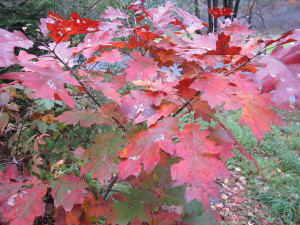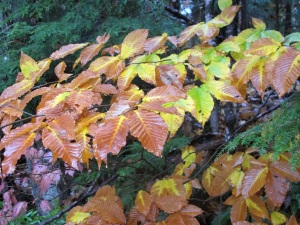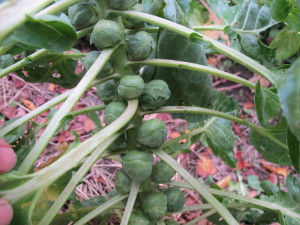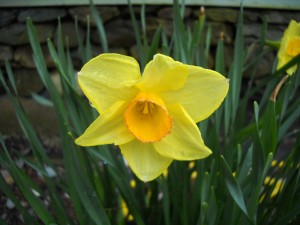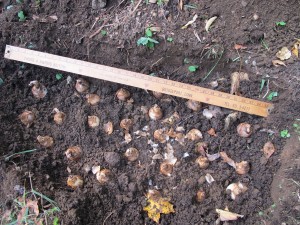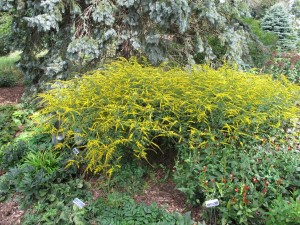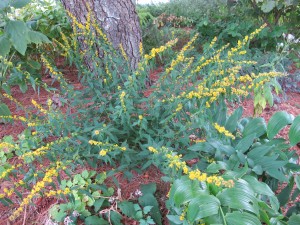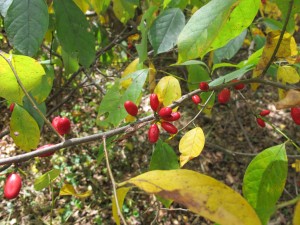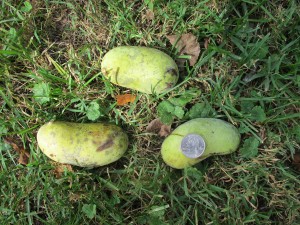The Under Appreciated Yellows and Browns of Fall
I took a walk this week along a country road and was delighted by the colors of the fall leaves. The reds –maples, largely – have fallen, but the yellows and browns are still on some trees and lovely. And once you develop an appetite for the less flashy leaves, you may want to plant a tree that will do”the late show” in years to come.
The oaks and beeches are particularly nice right now. Oaks hold onto to their leaves much later than the maples, developing a more subtle coloration: browns mixed with russet or carmine or maroon. Perhaps burnt umber. Worldwide there are some 500 species of oaks, but here in the wild forest, just a few. Seven are listed by Cooperative Extension as native to New Hampshire, but only two are common: northern red oak (Quercus rubra) and white oak (Q. alba). Additionally there are many pin oaks (Q. palustris) that have been introduced and used as good tough street trees. In fact, I’ve read that pin oak is the most commonly planted tree in America.
Oaks generally fall into two categories. Red oaks have leaves with pointed tips on their lobes; those with rounded leaf edges without any sharp points are considered white oaks. Red oaks produce acorns that only germinate after a cold period of 30 to 60 days in a process called stratification, while white oaks can germinate right away. The Washington oak, a white oak in Princeton, NJ, is over 275 years old.
Oaks, and nut trees in general, have tap roots that go down deep in the soil. White oaks really are best started by planting acorns, or getting a small tree at a nursery. By the time a white oak has a trunk that is two and a half inches in diameter, it’s too big to move. Pin oaks, one of the red oaks, have fibrous roots that are near the soil surface and can be planted or moved more easily.
Acorns have always fascinated little children (and me). They are shiny, smooth and shapely. They feel good when in your pocket. They have a little hat that stays on while on the tree, but falls off once ready to be planted. Acorns that are fertile always lose their caps, so don’t plant one wearing a cap.
Beeches (Fagus grandifolia) are also wonderful at this time of year. Like the oaks, beeches hang on to their leaves – some of the young trees keep their leaves until May, when new leaves push them off the branches. And although the fall color is yellow, never red, some will display stripes of green in leaves while the yellows develop. Eventually, they all turn brown and produce a nice sound as the dry leaves are teased by winter breezes.
Beeches have smooth gray bark that is splendid in winter. But many beeches suffer from a fungal disease which mars the bark and kills off older specimens. The trees are attacked by a scale insect that damages the bark, allowing a fungal disease called Nectria to infect the trees. According to a US Forest Service pamphlet, the scale insect arrived from Europe in the 1890’s and, like many foreign pests, had few enemies here in North America (it first appeared in Nova Scotia). These is no easy remedy if your beech trees are infected.
Another great tree for yellow leaves in the fall is the bottle brush buckeye (Aeseculus parviflora), a member of the horsechestnut family. I just planted one this fall because it has great spring flowers, will blossom nicely in the shade or part shade, and tolerates moist soil. I had just the right spot. The brilliant yellow fall leaves were a bonus.
My hybrid ‘Merrill’ magnolia has great yellow fall color, too. And if you get up close to the tree, you can see that it is loaded with small, bright red berries nestled in their pods. The buds for next year’s flowers are on the tree, too, and will become more noticeable once the leaves and seeds have dropped. The buds look like pussywillow buds on steroids.
At this time of year the weather tends to be a bit gloomy. Rainy cold weather is not much fun, and the sun sets by supper time. So what can a gardener do? Plant some acorns. My friend Joe Monninger of Plymouth, NH went out one fall about 10 years ago and planted a bunch of acorns. I called him this week to see how they did.
Ten years later- despite squirrels, lawn mowers and weed whackers – four of Joe’s acorns have grown to stand waist high. Not bad. He hadn’t done anything to improve the soil, he hadn’t fenced them to keep away deer. He just poked some holes in the ground and planted acorns. Even if he planted 25, he has four nice trees – and that’s not a bad return on his labor, if you ask me. If you plant some acorns, put one of those little white plant labels near each one so you will be careful to avoid stepping on them when young – or mowing them down. And in 300 years they might still be alive and producing acorns.
I believe in enjoying what I have. Take time, I say, to slow down and really look at the subtleties of nature and the garden. Red is not the only good fall color.
Henry is the author of 5 books. His web site is www.Gardening-Guy.com. You may send questions to him at henry.homeyer@comcast.net.
Cold Weather Crops
At this time of year I eat one of the “three B’s” from my garden every day: broccoli, Brussels sprouts or kale. All right, don’t get on my case. I know kale doesn’t start with a “B”. But it’s a brassica, the family that contains those other two, plus cabbage, rutabagas, cauliflower, kohlrabi and more. All are good cold weather crops.
In addition to surviving frosts, all the brassicas are healthy foods with lots of Vitamin C, soluble fiber and compounds thought to prevent cancer (though that is a little controversial). What you may not know is that boiling brassicas removes most of those cancer-fighting compounds, but steaming them or cooking them in a microwave dos not. Three to four minutes of steaming will cook your brassica nicely, but not steal many nutrients. But the best way to eat them is raw.
There are many varieties of broccoli, almost all are excellent. Arcadia is one that has done well for me, and is very cold hardy. I talked to my friend Chaz Meyers of Cornish Flat, N.H., who I think of as Mr. Broccoli. He and his wife, Jill Johnson, grow about 50 plants every year, freezing it and eating it all year. He told me that ‘Packman’ is favorite, in part because it produces lots of side shoots. He also likes ‘Waltham’ and ‘Gotham’ varieties.
Chaz recommends cutting the primary head of broccoli on an angle so that the stem, which is often a bit hollow, does not hold water (which might promote rot). He also suggests, if the summer is dry, watering your broccoli well after cutting the big head. That keeps the plant healthy and promotes the development of side shoots.
I once planted a little vegetable garden for a woman who didn’t know much about gardening. I planted two broccoli plants that produced magnificent heads in July. She ate them, with glee, and then pulled out the plants. Yikes! I regretfully explained that the most productive part of the plant are all those little “side shoots” that come after the main head. That, like the Energizer Bunny, broccoli keeps on producing for months. I’m still eating side shoots from plants I put in back in June.
Although broccoli are known for having little green caterpillars on them, mine have not had any this year – or none that I’ve seen. Maybe I’ve eaten a few. The best solution to the green caterpillar problem is just to soak the broccoli in cold water with a little salt in it before cooking. They will float up.
I dare say that my Brussels sprouts are perfect right now. Each is the diameter of a quarter- or a half dollar – and unbothered by any pests or diseases. I eat some every night for dinner: a dozen is just the right sized serving for me, so my six plant will keep me eating them for weeks. Brassicas are very hold hardy, and Brussels sprouts and kale will survive temperatures down to 20 degrees – or even colder. Frost helps to sweeten up their flavors.
Deer don’t bother my garden until it gets cold. Then they look for my Brussels sprouts and kale and broccoli. Once they waited until the night of December 24 to eat my Brussels sprouts, though that might have been the reindeer, waiting while Santa was inside the house. I recently took some preventive measures. I covered my kale with a scrap of chicken wire that I just draped over my plants, and then I surrounded the Brussels sprouts with some four-foot chicken wire. The broccoli will have to fend for itself – I’ve run out of fencing.
Kale is the perfect vegetable to freeze. Unlike spinach, it doesn’t get soggy when frozen. It keeps its character. I blanch it for a minute in boiling water. That kills the aging enzymes that would make it turn old and woody after just a few months in the freezer. When I take it out, I drop it into a sink full of cold water, spin it dry in my salad spinner, pat it dry with a tea towel, and put it in freezer bags. I suck out the air in the bags with a drinking straw. The straw goes into a zipper bag that is 99% closed, and I suck out the air. I snap the bag shut as I pull out the straw, and it’s ready to go in the freezer.
I know people that are gaga about kale chips, dried kale that is salty and crispy, the health-nut food to substitute for potato chips. I recently tried making my own but I’m neutral about them. Here’s what I did: I stripped the leaves off the central stem, and tore the leaves into pieces and put them in a big bowl. I coated them with a garlic and olive oil solution (I used 3 cloves garlic and a few tablespoons of oil). I sprinkled pepper flakes or nutritional yeast on the leaves and tossed some more. I added salt, but not a lot.
Then I put some kale chips in the oven at 150 degrees for 2 hours with the convection fan blowing, others in a food dehydrator at 135 degrees for 2.5 hrs. Maybe I needed to use more salt or oil, but I was aiming for a health food. And this tasted like something a little too healthy. Oh well. They’re crispy, but they’re definitely not as good as potato chips. Darn!
Eating the brassicas from my garden at this time of year is a wonderful way to transition to winter. I have food in the freezer from the summer, and root crops stored in the cellar. But it feels great to walk to the garden with a knife and cut something fresh for dinner.
Henry Homeyer is a gardening educator, speaker and writer. Reach him at henry.homeyer@comcast.net.
Planting Garlic
Garlic is one of those magical flavors that give foods depth of flavor and the richness of another world. Italian food, French food, Indian food – these all include liberal use of garlic. Why the English decided on fish and chips and boiled dinners as their staples is a mystery to me. Maybe they can’t grow garlic. But I’ve been growing garlic for my kitchen for decades. It’s easy to grow and now is the time to plant it for next year.
Your first task is to find some garlic suitable for planting. You can’t just go the grocery store and buy some. Most commercial (non-organic) garlic has been treated with chemicals to keep it from sprouting. Instead, go to your garden center to buy some – or get a few heads of garlic from a farm stand or a friend who grows it.
Here in New England the recommended type of garlic is called ‘hard neck garlic’ and it survives our cold weather nicely. Soft neck garlic, commonly grown in California, is less cold tolerant. It is the type that can be braided and hung in the kitchen. Hard neck garlic sends up a stiff stalk, called a scape, which grows out of the middle of the bulb – a stiff neck, if you will.
Hard neck garlic generally has a stronger, richer flavor with more bite. It also comes in a wide range of flavors – just as different varieties of tomatoes and sweet corn have distinct flavors. Hardneck garlic is often classified as either rocambole, porcelain or purple stripe. Rocambole garlic has a tan outer covering and usually produces up to a dozen cloves per bulb. Porcelain garlic has a satiny white wrapper and tend to produce larger cloves with as few as four per bulb. Purple stripe garlic is one of my favorites – it is productive, tasty and generally a nice, plump size.
I like to say that everyone would be a gardener if growing all vegetables were as easy as growing garlic. There are just three steps to growing garlic: planting it, mulching it, and harvesting it. That’s right, if you mulch well it will grow well and you will never – or rarely – need to weed.
I grow garlic (and all my vegetables) in wide, mounded beds. Each bed is 30 to 36 inches wide, and mounded up 4 to 6 inches above the walkways. A short-tined garden rake or hoe is useful for shaping the beds, and to gather up loose soil from the walkways.
The first step when planting garlic is to remove any weeds from the soil. Then I enrich the soil by adding 3 or 4 inches of compost on top of the bed I am planting it in. I use a garden fork or my CobraHead hand weeder to loosen the soil and stir the compost into the top few inches of soil. Rototilling would mix the compost in deeper – good for drainage in a clay soil if you have it, but away from the roots of my garlic.
Rows of garlic need to be spaced 6 to 8 inches apart. Most years I plant short rows across my wide beds, but sometimes I will plant rows down the length of the beds – it really doesn’t matter which way you do it. I create furrows with a hand tool in the fluffy soil of my bed and sprinkle on some bagged organic fertilizer, then mix that in.
It is important to plant your garlic right side up. If you look at a bulb of garlic, you should be able to see roots, or where the roots have been cut off. The top of each clove has a slightly pointy tip, and the bottom has a small, flat scar. And of course, when looking at a bulb of hard neck garlic you can see where the scape grew. If you plant the cloves upside down, they use up a lot of energy trying to get started and grow toward the sun.
To plant, just push each clove into the prepared soil about 4 inches away from its nearest neighbor. The top of the clove should be 2 to 3 inches beneath the soil after you cover it up. Pat the soil with your hands to firm it up.
The last step is to mulch. I use mulch hay because it is inexpensive, but straw is fine, and should have fewer seeds. I put a thick, fluffy layer of hay over the entire bed – and about a foot deep. Fall rains and winter snows will compact the mulch to a 3 to 4 inch thick layer of mulch that should keep out all weeds – while allowing the garlic scapes to push through in the spring.
Garlic is ready to pick in July or August. The scapes will curl and dance as they grow, and are wonderful in a vase with flowers. The scapes are also tasty – you can chop them and add to stir fries or omelets. Store your garlic crop in a cool dark place for best storage. And don’t eat it all! Save some for planting your next crop.
I’ve been told that garlic has cancer-fighting compounds, and that it’s best to chop or press you garlic 10 minutes before cooking it to preserve the best effects. And it’s supposed to be good for keeping away vampires, not just cancer. Me? I find it necessary for a good spaghetti sauce!
Henry Homeyer is a garden designer, coach and the author of 4 gardening books. His web site is www.Gardening-Guy.com.
Planting Bulbs
This is one of my favorite times of the year. Trees are turning brilliant colors, food from the garden is in the larder, and it’s bulb planting time. Some bulbs have a bad reputation: tulip bulbs for example, are often food for squirrels, and their blossoms are often munched by deer. But I know that if I plant daffodils, I’ll get blossoms six or seven months later and nothing will even think about eating them. Daffies are sure winners.
Daffodils will thrive and survive in sun or part shade. I grew up in Connecticut in a house that had a nice wooded back yard and a path through it that was lined with hundreds of daffodils. Maybe thousands. They multiplied and survived and bloomed year after year.
The soil was a dark woodland soil nourished by decomposing leaves. There was good drainage – which is important, as bulbs can rot if planted in heavy, wet soil. Occasionally my parents would dig up some big clumps and divide them, but really, we did almost nothing and the daffodils thrived.
I called Brent and Becky’s Bulbs, a family-owned business in Virginia to talk about my experience with daffodils. Their catalog says daffodils need half a day of sunshine even after the leaves come on. Why, I asked owner Becky Heath, did those daffodils of my youth do so well in our woods?
Becky said that daffodils do best in nutrient-rich soil. Our soil was that. She also said that some types do better than others. There are more than a dozen categories of daffodils, and of these, the Cyclamineus group includes many of the most shade-tolerant varieties. These are not the classic daffodil: their petals lean backward, away from their trumpet – sort of like the ears of a dog with his head out the window of a fast moving car.
Becky also told me that daffodils in the Cyclamineus group also do better than other types of daffodils in wet, heavy clay soils. ‘Tweety Bird’, ‘Jack Snipe’ and ‘February Gold’ are examples in this group.
If you read a package of daffodil bulbs carefully, you will probably see that each variety is labeled Early, Mid-Season or Late. In the past I have always selected some from each time period. But Becky Heath suggested to me that I focus primarily on bulbs that bloom early because much of my property is getting quite shady – especially where I want to plant bulbs – and early bloomers do better in part shade than late bloomers. Examples of early spring daffodils include ‘Rijnveld’s Early Sensation”, and many of the miniature varieties.
Bulbs expend a huge amount of energy in order to produce flowers. Those bulbs need to be “re-charged” each year or they will decline and have less energy for blooming next year. They do this through the miracle of photosynthesis – sunshine on their leaves produces food for the bulbs. Leaves on early-blooming bulbs generally come up and get to work early in the spring – before trees have leaves. If a bulb can get the needed energy before the leaves appear, it will thrive. Many daffies still have green leaves through June.
That theory is supported by this: my snowdrops and Scilla and Glory-of-the-Snow have thrived and multiplied, even in shade. They are small flowers that come up in March, long before the maples have leafed out. They have done much better than the daffodils planted near them.
According to Becky Heath, another factor in the success or failure of bulbs is whether or not they are hybrids. Hybrids don’t self-pollinate and re-seed themselves. Those that are called “species” daffodils do spread and naturalize by seed, she said. Thus some of the older varieties do better than the “new, improved” hybrids.
Some gardeners plant bulbs one-by-one with a little tool that can dig a round hole when plunged into the soil. I find that hard work, and slow. I prefer to dig one big hole that will hold 25 bulbs or more. I dig the hole, add some organic fertilizer and scratch in some compost. I want daffodils to have about 6 inches of soil covering the bulbs, or less for the small bulbs.
After a long winter, I long for color. You may think of daffodils as just one color – yellow – but some varieties can offer white, orange, pinkish peach, and lots of variations of colors I can’t name. But whatever you choose, plant some bulbs now for a punch of color in the spring.
Henry’s e-mail address is henry.homeyer@comcast.net, or you may reach him at P.O. Box 364, Cornish Flat, NH 03746. If you have a question, please include a self-addressed stamped envelope.



